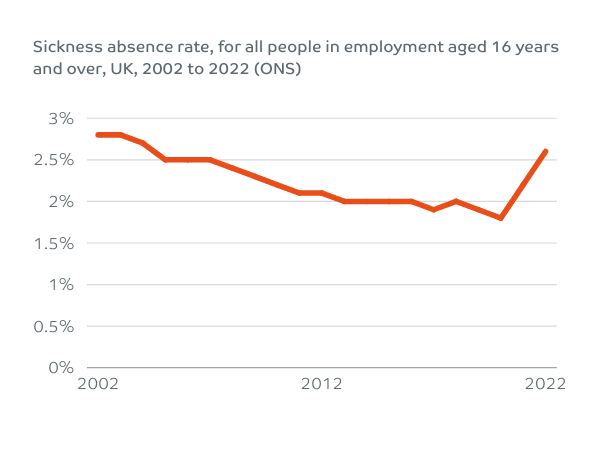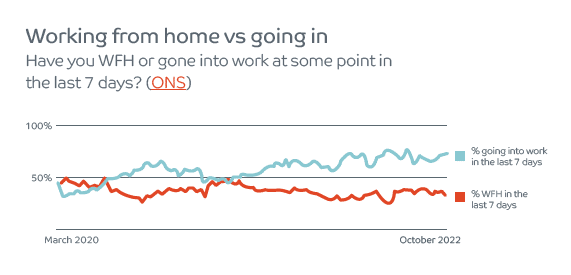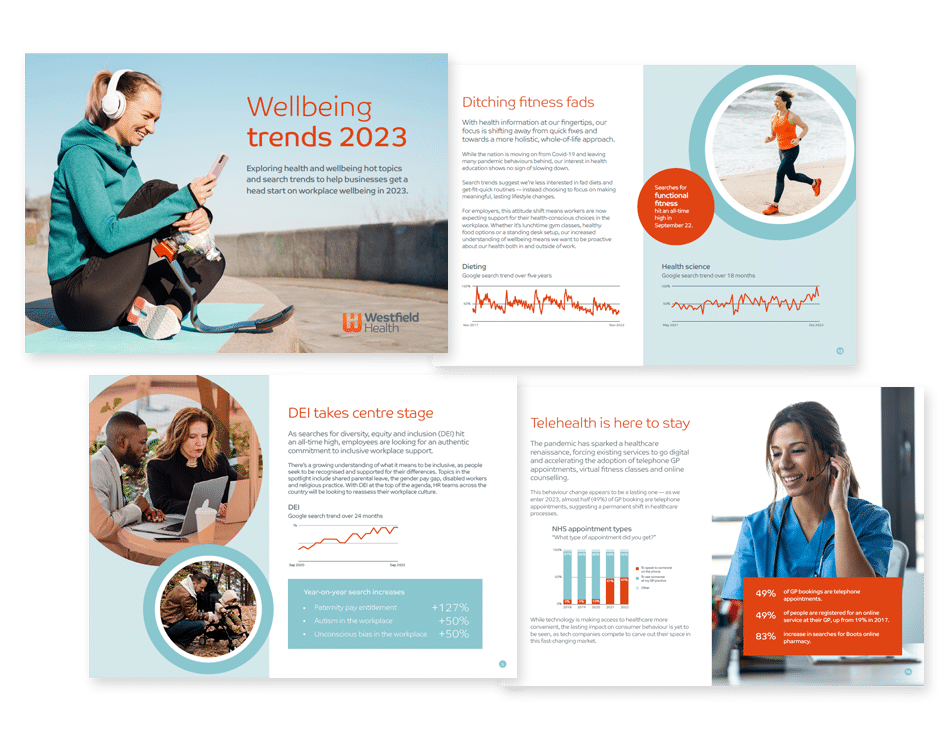Our 2023 Wellbeing Trends report explores the trending health and wellbeing topics and what they mean for UK businesses in the coming year. The report uses data from sources including the Office for National Statistics, the NHS, Google search trends and our own wellbeing research to help you plan and prioritise your wellbeing support.
One theme that’s still on the rise is digital health, as individuals seek online services to improve their wellbeing and businesses continue develop their virtual offices. In this blog, we explore digital transformation in the NHS and how businesses can use tech to support their people.
Teleheath is here to stay
The pandemic has sparked a healthcare renaissance, forcing existing services to go digital and accelerating the adoption of telephone GP appointments, virtual fitness classes and online counselling.
- 49% of GP bookings are telephone appointments.
- 49% of people are registered for an online service at their GP, up from 19% in 2017.
- 83% increase in searches for Boots online pharmacy.
This behaviour change appears to be a lasting one — as we enter 2023, almost half (49%) of GP bookings are telephone appointments, suggesting a permanent shift in healthcare processes.
While technology is making access to healthcare more convenient, the lasting impact on consumer behaviour is yet to be seen, as tech companies compete to carve out their space in this fast-changing market.
Digital goes deeper
Worldwide sales of Fitbits fell by around 50% between 2016 and 2022. But trends suggest that rather than ditching the digital tech, people are looking for a more in-depth view of their health than our current wearables can offer.

Google trends suggest that people are using personalised health tracking as a more meaningful way to monitor their wellbeing. This includes looking beyond step counters (-47%) towards more in-depth measures such as blood pressure (+48%), cholesterol (+21%) and glucose monitoring (+17%).
DNA genetic health testing service 23andMe saw a 174% increase in search volume in 2022, as people look for personalised data that helps them take charge of their health.
The future of remote work
Almost three years since WFH went mainstream, the practicalities of home and hybrid working continue to evolve. While some organisations strive to make their virtual office visions a reality, others are calling for an end to the work from home ‘experiment’ and demanding employees work on site full time.

Even pre-pandemic, the tech sector had been driving innovation in remote working, as leaders looked for creative solutions to help employees work together even when they’re apart. In recent months we’ve seen everything from coffee break Slack channels to virtual offices built in the Metaverse.
And despite calls for a return to the office, our recent research found that flexible working remains the most coveted employee benefit, suggesting that remote opportunities are as appealing as ever.
With labour shortages plaguing the UK job market and many high-profile employers continuing with a remote-first approach, employees are likely to vote with their feet to find the working style that suits them best.
Time to switch off?
After two years of digital overload, the pandemic tech bubble is starting to deflate. In its place emerges a pushback against ‘always on’ culture, as people look to log off and take a more relaxed approach.
- Google searches for the term ‘soft living’ saw a 600% year-on-year increase in 2022, with interest peaking in September.
- The Oxford English Dictionary revised their entry on stress, adding new definitions for stress reliever, stress disorder and stress bunny.
With Covid, the Russia-Ukraine war and the cost-of-living crisis dominating the headlines, the workforce is going through a period of shared cumulative stress. And it’s no surprise that people are looking for some respite in their daily routines.
Quiet quitting hit the headlines in September, highlighting the prevalence of disengaged employees who prefer to do the minimum required in their role. Around the same time we saw a social trend around ‘soft life’ — a lifestyle designed around minimal stress, self-care and easy living.
This need to disconnect found its way into our workplaces in the form of designated quiet hours, ‘no meeting’ days and the four-day working week. As we enter 2023, employers must monitor the impact of stress on their people with an awareness that online-only solutions might alienate those who are desperate to switch off.
Discover the top wellbeing trends for 2023
To find out more about upcoming health and wellbeing trends for 2023, download our free Wellbeing Trends report. It explores emerging topics to give businesses insight into employee wellbeing and benefits trends in the coming months.
